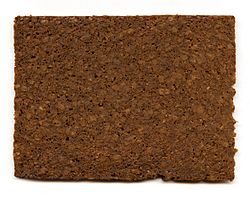Pumpernickel facts for kids

A slice of pumpernickel bread
|
|
| Type | Rye bread |
|---|---|
| Place of origin | Germany |
| Region or state | Westphalia |
| Main ingredients | Rye flour, rye berries |
Pumpernickel is a special kind of bread made from rye. It is usually heavy and a little sweet. This bread is traditionally made using a sourdough starter and coarsely ground rye grains. Today, it is often made with both rye flour and whole rye grains, which are also called "rye berries."
Long ago, pumpernickel was a simple food for farmers. But during the 1900s, it became popular in many places, like delis and supermarkets. The pumpernickel you find in Europe and North America today can be different. For example, the North American version might have added colors or flavors. It might also use wheat flour, be baked at a higher heat, and cook much faster.
Contents
What's in a Name? The Story of Pumpernickel
The name "pumpernickel" has a few interesting ideas about where it came from. Some people think it comes from an old word in the Bavarian region of Germany. This word might have meant "hard," describing how tough it was to grind the rye grains or how dense the bread turned out.
One fun, but probably not true, story involves the famous leader Napoleon. When he was in Germany, he supposedly asked for bread. He was given this dark rye bread. The story says Napoleon declared it wasn't good enough for him, the emperor. Instead, he said it was "pain pour Nickel," meaning "bread for Nickel," his horse! Another version says he thought it was only "bon pour Nickel," meaning "good for Nickel." However, there's no proof that Napoleon had a horse named Nickel.
This funny story about the horse is a "folk etymology." It's a popular tale that explains a word's origin, even if it's not historically accurate.
Pumpernickel in Europe
Pumpernickel has been famous in the Westphalia region of Germany for a very long time. It was first mentioned in writing around 1450. Westphalian pumpernickel is special because it uses coarse rye meal and is baked for a very long time. This long baking process gives the bread its unique dark color.
Most traditional rye breads, including pumpernickel, are made with a sour dough starter. This starter helps the bread rise and gives it a special flavor. The acid in the sourdough also helps keep the bread's structure. Sometimes, commercial bakeries add citric acid or lactic acid with yeast to help the bread rise faster.
Real German pumpernickel doesn't use any added colors. Its deep brown color comes from a natural process called the Maillard reaction during baking. This reaction also gives the bread its sweet, dark chocolate or coffee-like flavor and an earthy smell.
To make this special bread, loaves are baked in long, narrow pans with lids. They cook for a very long time, usually 16 to 24 hours, in a low-temperature oven (around 120°C or 250°F) filled with steam. Because it's baked in a lidded pan, Westphalian pumpernickel has very little or no crust. It's quite similar to another dense rye bread called Vollkornbrot, which also has lots of whole grains.
Pumpernickel is also popular in the Netherlands, where it's called roggebrood. It has been a common food there for hundreds of years. In Denmark, a similar rye bread called rugbrød is a very important part of their diet. In Germany, you can often find pumpernickel sliced in small packages at supermarkets. It's sometimes served with fancy foods like caviar or smoked salmon as a small snack before a meal.
Pumpernickel in North America
While some large bakeries make pumpernickel bread for stores, many smaller shops and families in America still use old recipes. They bake the bread for the traditional long times. Some mass-produced pumpernickel in North America might use natural colors like molasses, caramel color, coffee, or cocoa powder. These are added to make the bread look like the dark brown German pumpernickel.
Modern bakeries often add wheat flour to their pumpernickel. This helps the bread rise more and gives it a softer texture because of the gluten in wheat. They also use commercial yeast to make the bread rise much faster than traditional sourdough. To make more bread quickly, they skip the slow baking process that German pumpernickel uses. This can make the bread taste more like a dark rye bread than true pumpernickel.
However, some special shops and bakeries in America still use recipes that are hundreds of years old. They often sell other German foods too. Pumpernickel is also a popular flavor for bagels, especially in New York.
Images for kids
See also
 In Spanish: Pumpernickel para niños
In Spanish: Pumpernickel para niños






